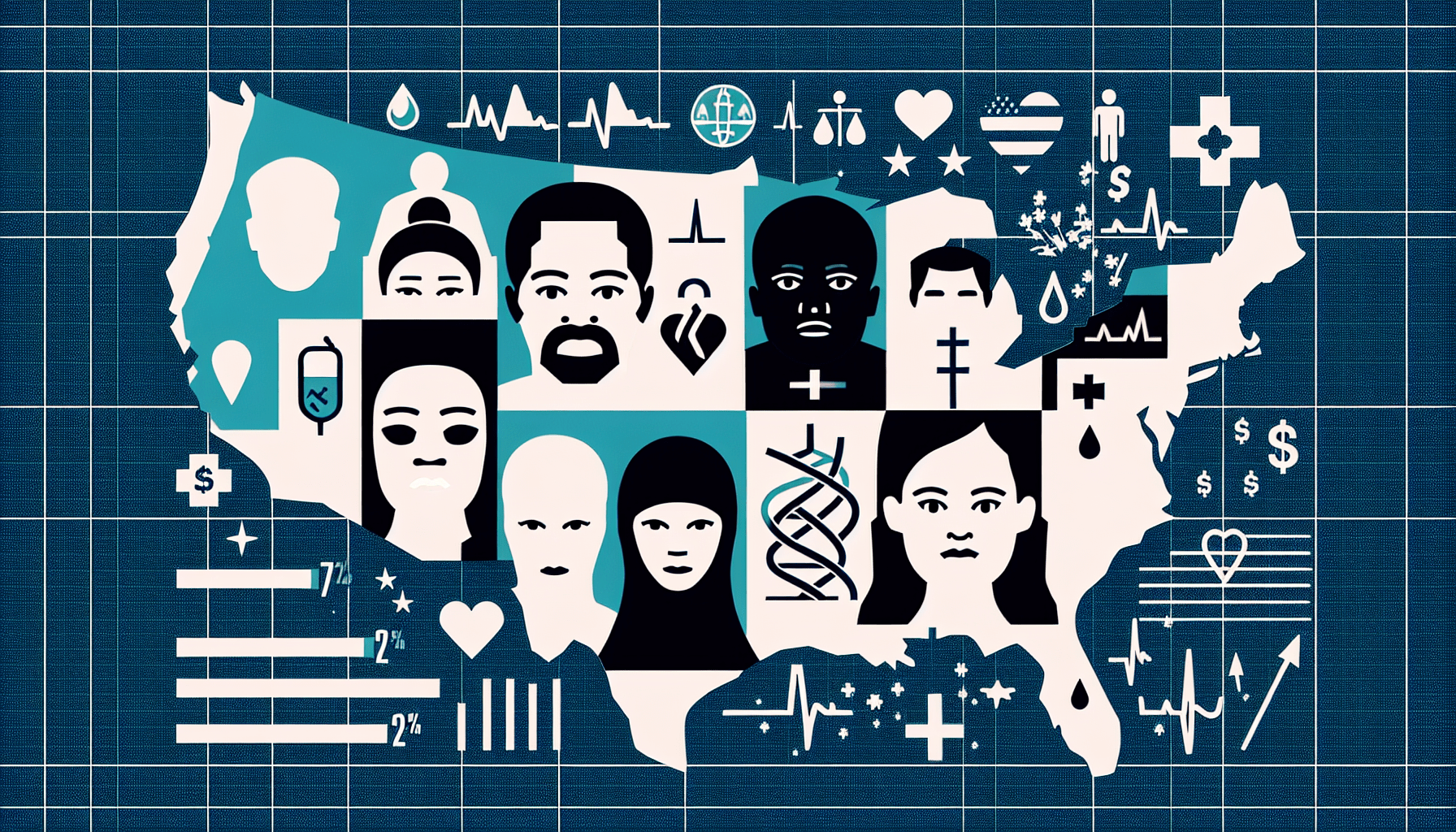In this article, we will explore the topic of health disparities in the United States, specifically focusing on how these disparities relate to race. We will discuss the various factors that contribute to these disparities, such as access to healthcare, socioeconomic status, and underlying systemic issues. By understanding the extent of these disparities and their impact on different racial groups, we can work towards achieving a more equitable and inclusive healthcare system for all. So, let’s delve into this important issue and start bridging the gap towards better health outcomes for everyone.
Overview of Health Disparities
Definition of health disparities
Health disparities refer to the differences in health outcomes and access to healthcare experienced by different racial and ethnic groups. These disparities are usually observed in areas such as disease prevalence, healthcare utilization, healthcare quality, and health behaviors.
Importance of addressing health disparities
Addressing health disparities is crucial for promoting social justice and ensuring equal access to healthcare for all individuals, regardless of their racial or ethnic background. These disparities not only result in unequal health outcomes but also have a negative impact on the overall well-being and productivity of affected communities.
Factors contributing to health disparities
Several factors contribute to health disparities among different racial and ethnic groups. These factors can include socioeconomic status, education level, access to healthcare, discrimination, cultural beliefs, and environmental conditions. By understanding and addressing these factors, we can work towards reducing health disparities and improving health equity for all.
Demographics
Racial and ethnic composition of the US population
The racial and ethnic composition of the US population is diverse and continues to evolve. As of the latest census data, the US population consists of various racial and ethnic groups, including White, Black or African American, Asian, Native Hawaiian or Other Pacific Islander, American Indian or Alaska Native, and Hispanic or Latino. Each of these groups has its unique health needs and challenges.
Population growth and projections by race
Projections suggest that the US population will become increasingly diverse in the coming years, with racial and ethnic minority groups representing a larger proportion of the total population. This demographic shift highlights the importance of addressing health disparities to ensure equitable healthcare access and outcomes for all individuals.

Access to Healthcare
Insurance coverage disparities
One significant factor contributing to health disparities is the disparities in insurance coverage. Racial and ethnic minority groups are more likely to be uninsured or have inadequate health insurance compared to White individuals. Lack of insurance can lead to delays in seeking healthcare, reduced access to preventive services, and higher out-of-pocket costs for necessary treatments.
Barriers to healthcare access
In addition to insurance coverage disparities, various barriers prevent racial and ethnic minority groups from accessing healthcare services. Some common barriers include geographical location, language barriers, cultural beliefs and attitudes, lack of trust in the healthcare system, and discrimination. Addressing these barriers is crucial to ensure equitable access to healthcare for all individuals.
Disparities in healthcare quality and utilization
Healthcare quality and utilization also differ among different racial and ethnic groups. Minority populations may experience lower-quality care, longer wait times, and fewer treatment options compared to their White counterparts. This disparity in healthcare can lead to poorer health outcomes and increased morbidity and mortality rates for minority groups.
Prevalence of Health Conditions
Leading causes of death by race
The leading causes of death can vary among different racial and ethnic groups. For instance, heart disease and cancer are the leading causes of death for most racial and ethnic groups in the United States. However, rates of specific diseases, such as diabetes or certain types of cancer, may differ between groups. Understanding these variations is crucial for developing targeted interventions and healthcare policies to address health disparities effectively.
Chronic diseases and their impact on different racial groups
Chronic diseases, such as diabetes, hypertension, and obesity, disproportionately affect racial and ethnic minority groups. These diseases not only contribute to higher mortality rates within these communities but also result in adverse health outcomes and reduced quality of life. Addressing the disparities in chronic disease prevalence and management is essential for improving overall health outcomes and reducing health disparities.

Health Behaviors and Risk Factors
Differences in health behaviors (e.g., smoking, physical activity)
Health behaviors such as smoking, physical activity, and dietary habits can significantly impact health outcomes. These behaviors often vary among different racial and ethnic groups. For example, smoking rates may be higher among certain minority populations, while physical activity levels may differ across racial and ethnic lines. Understanding and addressing these disparities in health behaviors is vital for promoting healthier lifestyles and reducing health disparities.
Contributing risk factors (e.g., socioeconomic status, education)
Various risk factors contribute to health disparities among racial and ethnic groups. Socioeconomic status and educational attainment are key determinants of health outcomes, with lower socioeconomic status and educational levels often associated with poorer health. Additionally, other factors such as limited access to healthy food options, exposure to environmental toxins, and discrimination can also contribute to health disparities. Addressing these risk factors is crucial for achieving health equity.
Maternal and Child Health Disparities
Infant mortality rates by race
Infant mortality rates vary significantly among different racial and ethnic groups. African American infants, for example, have consistently higher mortality rates compared to White infants. This disparity is influenced by various factors, including social determinants of health, access to prenatal care, maternal health, and birth outcomes. Efforts to reduce infant mortality must prioritize addressing these disparities and promoting equitable healthcare access for all mothers and infants.
Disparities in prenatal care and birth outcomes
Prenatal care and birth outcomes also exhibit disparities among different racial and ethnic groups. Minority populations may face challenges in accessing adequate prenatal care, resulting in higher rates of preterm birth, low birth weight, and other adverse birth outcomes. Addressing these disparities requires improving access to prenatal care, addressing social determinants of health, and promoting culturally competent care for expectant mothers from diverse backgrounds.

Mental Health Disparities
Prevalence of mental health conditions in different racial groups
Mental health conditions affect individuals from all racial and ethnic backgrounds, but disparities exist in terms of prevalence, treatment, and outcomes. For instance, certain minority populations may experience higher rates of depression or anxiety, but lower rates of receiving appropriate mental health care. Understanding the unique mental health challenges faced by different racial and ethnic groups is essential for developing effective interventions and support systems.
Access to and utilization of mental health services
Barriers to accessing mental health services contribute to mental health disparities among racial and ethnic minority groups. Limited availability of culturally competent care, lack of insurance coverage, stigma surrounding mental health, and language barriers can all hinder individuals from seeking and utilizing mental health services. Overcoming these barriers and promoting equitable access to mental health care is crucial for addressing mental health disparities.
Environmental and Social Determinants of Health
Impact of neighborhood conditions on health outcomes
Neighborhood conditions, including access to quality housing, safe environments, and availability of healthcare services, significantly impact health outcomes. Racial and ethnic minority communities often face disparities in these neighborhood conditions, leading to poorer health outcomes. Addressing these environmental determinants of health is crucial for reducing health disparities and promoting equitable access to health resources.
Structural racism and its effects on health disparities
Structural racism, including discriminatory policies, practices, and systems, plays a significant role in perpetuating health disparities. These systemic inequities contribute to differences in socioeconomic status, educational opportunities, access to healthcare, and exposure to environmental toxins among racial and ethnic groups. Recognizing and dismantling structural racism is essential for achieving health equity and eliminating health disparities.

Efforts to Reduce Health Disparities
Government initiatives and policies
The government plays a crucial role in addressing health disparities through initiatives and policies. Efforts include expanding access to affordable health insurance, increasing funding for healthcare programs in underserved communities, implementing culturally competent care guidelines, and promoting diversity in the healthcare workforce. These governmental initiatives aim to reduce disparities and ensure that all individuals have equal access to quality healthcare.
Community-based interventions and programs
Community-based interventions and programs are vital for addressing health disparities at the grassroots level. These initiatives can include outreach and education programs, community health clinics, partnerships with local organizations, and culturally tailored interventions. By involving the community, these interventions promote trust, address social determinants of health, and provide holistic support for individuals and families.
Health equity research and advocacy
Research focused on health equity and advocating for policies that address health disparities are essential components of efforts to reduce disparities. Health equity research helps identify the root causes of disparities and develops evidence-based interventions. Advocacy efforts aim to raise awareness, influence policy changes, and ensure that health equity remains a priority in public health agendas.
Future Outlook
Current trends and predictions
Current trends indicate that health disparities remain persistent, although efforts are being made to address them. However, projections suggest that the US population will continue to become more diverse, necessitating ongoing strategies to reduce disparities and improve health equity.
Importance of ongoing research and interventions
Ongoing research and interventions are crucial for understanding the evolving nature of health disparities and devising effective strategies to address them. By staying informed about the latest trends, conducting research, and continuously evaluating interventions, we can adapt our approaches and ensure that efforts to reduce health disparities are responsive and effective.
Goals for achieving health equity
The ultimate goal is to achieve health equity, where all individuals have the same opportunities to achieve optimal health outcomes regardless of their racial or ethnic background. This involves addressing systemic inequities, promoting social justice, providing equitable access to healthcare, and pursuing comprehensive approaches that address the complex factors contributing to health disparities.
In conclusion, health disparities in the United States persist across various domains, including access to healthcare, health behaviors, prevalence of health conditions, and environmental and social determinants of health. It is crucial to address these disparities through government initiatives, community-based interventions, research, and advocacy efforts. By working towards health equity, we can ensure that all individuals, regardless of their race or ethnicity, have equal opportunities to achieve optimal health and well-being.

